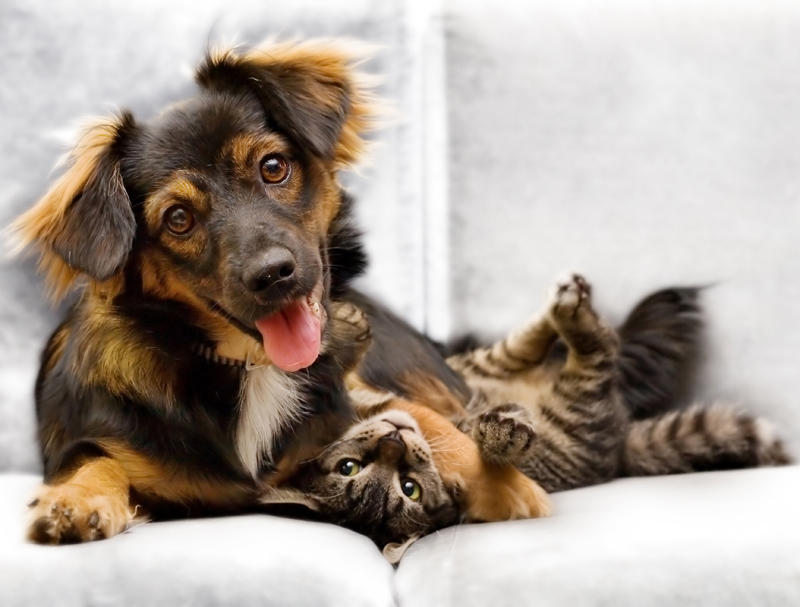Cats and dogs may seem as different as night and day, but they can learn to get along if you take it slow and steady with the introductions.
When Nora’s neighbor got a new dog, her cat Yeti was less than pleased. Although a chain link fence separated the yards, and Yeti only went outdoors when supervised, he was initially terrified of the dog, and would run for the door as soon as the beagle mix trotted up to the fence for a closer look. The dog’s occasional loud baying spooked Yeti even further and it was more than a week before he felt comfortable enough to stay outside for more than a few minutes, let alone approach the fence. After awhile, however, Yeti accepted the canine newcomer, and was eventually able to touch noses with her through the fence. “They’ve never really made friends, though,” Nora says. “It’s more of an uneasy truce.”
By nature, dogs and cats were not made to share the same living environment. But it doesn’t mean they can’t. Statistics from the American Veterinary Medical Association show that 46% of cat households include at least one dog. However, the introduction of a new dog or puppy into your cat’s home should be done slowly over a couple of weeks, to make sure the two are able to live peacefully together in the same space.
Be a pack leader
Ideally, the best time to introduce the two species is when they are kittens and puppies. If this isn’t possible, and you are bringing an adult dog into the house for the first time, you will need to establish yourself as pack leader to make sure the dog knows you are in control of the situation. Failing to assert yourself as the one in command can result in a potentially dangerous first meeting between the new dog and your cat.
“A dog’s reactions usually fall into several categories,” explains animal behaviorist Dr. Suzanne Hetts. “Some immediately view cats as prey and will chase them with the intent to hurt them. Many will be intensely curious about the cat. That curiosity can turn into friendly or aggressive behavior depending in part on the cat’s response. The dog may start out just wanting to play, but if the cat feels threatened and behaves aggressively, the dog may respond in kind.”
Prior preparations
Before bringing your new dog or puppy home, you need to prepare your cat by making some changes to his environment such as moving his food bowl to an area where the dog can’t reach it, like the countertop, and putting the litter box someplace where the dog can’t smell it (dogs are notoriously attracted to cat feces).
Do this well ahead of introducing the newcomer. Cats don’t like change, and it will take your kitty some time to get used to his bowls and litter box being moved. Making these changes the same day you bring the dog home will only stress your cat out even more.
Easy does it
1.When you bring your new dog or puppy home, don’t let her see the cat right away. Instead, confine her to a room with the door closed. Now you can commence with introductions by letting the two animals sniff each other under the door. Use treats to reward appropriate behavior from the dog.
“Micro-managing these introductions and moving at a snail’s pace is key,” says Dr. Hetts. “Moving too quickly and allowing the animals too much access to one another too soon can result in fearful or aggressive reactions, and will only prolong the introductory period and make success less likely.”
2.To get your new canine better acquainted with the feline of the house, get them used to each other’s scent. Place items belonging to each animal in the other’s living space. Alternatively, when the dog is outside, bring the cat into her area to sniff around, and vice versa if your cat goes out.
3.After a few days of being isolated from each other, it is now time to allow your dog and cat to meet nose to nose. Keep your dog on a leash or in a wire crate, and allow her to watch the cat from a distance. Gradually, your cat will get closer and the dog will get used to him being around.
4.If your dog becomes too excited during these first meetings, distract her with toys or trips outside for exercise to help her calm down. Training her to “sit” or “stay” will also help her calm and focus on something else. High praise and a treat will encourage good behavior. Don’t forget to praise your feline friend too! “Cats and dogs that become familiar with each other during this sensitive socialization period should be more likely to view individuals of that species as friends and peers rather than predator or prey,” says Dr. Hetts.
She adds that it’s important to be patient. “Cats and dogs vary as to how quickly they move through this introductory phase. Some may accept one another within a few days, while others may take weeks or months to tolerate one another.”
Troubleshooting
Ideally, your cat and new dog won’t be able to share the same living area until the dog stops showing signs of wanting to chase the cat, and learns to be calm when he is around. Nevertheless, you can’t guarantee your dog won’t sometimes want to chase your cat, even if only in fun.
- Make sure your kitty has spots around the house to escape to, and that he knows where those spots are. You can provide safe places for him by blocking off rooms with baby gates, tall enough so your dog can’t jump over them. A better option is to install pet doors large enough for only your cat to get through. The doors can lead to another room, the basement, or if you let your cat out, to the outdoors. High perches that your cat can jump or climb to are another alternative.
- Dr. Hetts says that relationship problems between cats and dogs are most likely to be over personal space, safety and predation, rather than territory or dominance. Breeds such as the border collie, Akita, Australian cattle dog and Weimeraner have what is called a high “prey drive”, which is a genetically inherited attribute. These dogs will always have a natural instinct to chase and sometimes even injure and kill small animals, despite training. When adopting a new dog for a feline household, it’s probably a good idea to avoid these breeds.
- If you just don’t feel you can trust your new dog, even after trying all of the above, consult a professional trainer or animal behaviorist for help before allowing her and the cat to mingle freely.
If you take the proper precautions, practice patience, take your time and consistently reward good behavior from your new canine friend, the chances are good that she and your cat will learn to get along well. In time, they may even become best friends!







No Comment